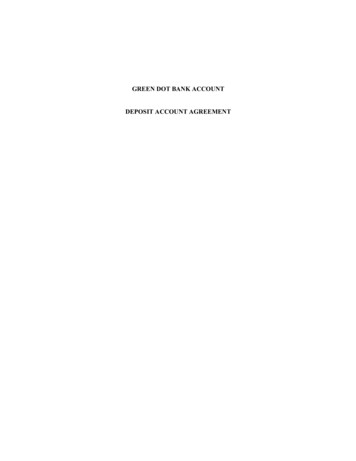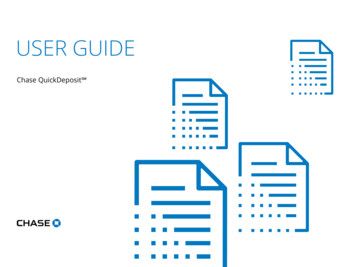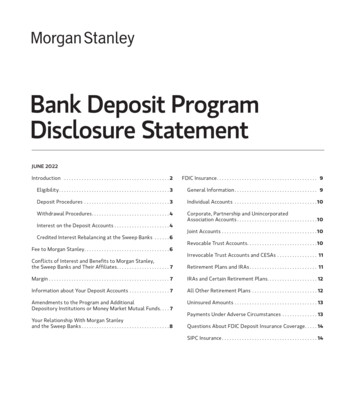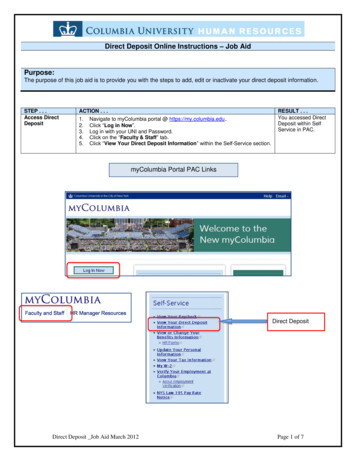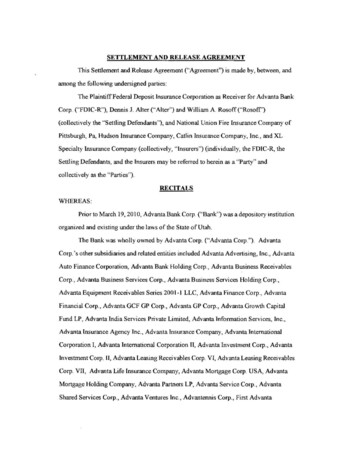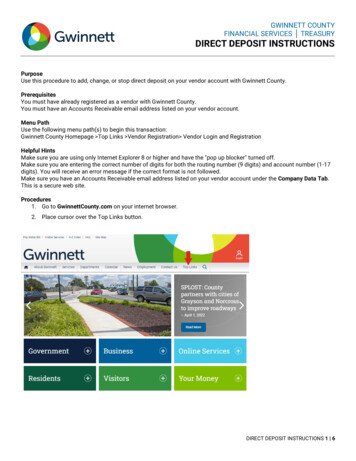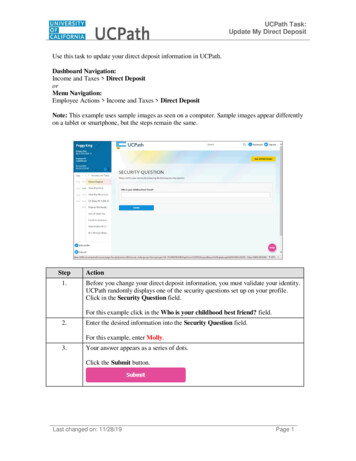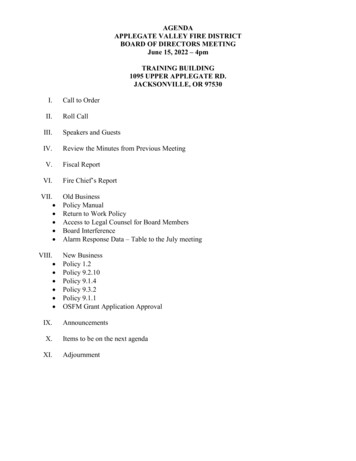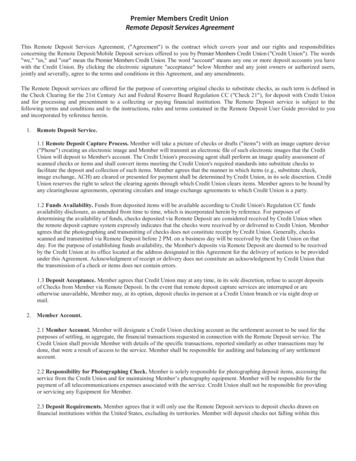
Transcription
WP/14/118Deposit Insurance DatabaseAsli Demirgüç-Kunt, Edward Kane, and Luc Laeven
WP/14/118 2014 International Monetary FundIMF Working PaperResearch DepartmentDeposit Insurance DatabasePrepared by Asli Demirgüç-Kunt, Edward Kane, and Luc Laeven1Authorized for distribution by Stijn ClaessensJuly 2014This Working Paper should not be reported as representing the views of the IMF.The views expressed in this Working Paper are those of the author(s) and do not necessarilyrepresent those of the IMF or IMF policy. Working Papers describe research in progress by theauthor(s) and are published to elicit comments and to further debate.AbstractThis paper provides a comprehensive, global database of deposit insurance arrangementsas of 2013. We extend our earlier dataset by including recent adopters of deposit insuranceand information on the use of government guarantees on banks’ assets and liabilities,including during the recent global financial crisis. We also create a Safety Net Indexcapturing the generosity of the deposit insurance scheme and government guarantees onbanks’ balance sheets. The data show that deposit insurance has become more widespreadand more extensive in coverage since the global financial crisis, which also triggered atemporary increase in the government protection of non-deposit liabilities and bank assets.In most cases, these guarantees have since been formally removed but coverage of depositinsurance remains above pre-crisis levels, raising concerns about implicit coverage andmoral hazard going forward.JEL Classification Numbers: G20Keywords: Deposit insurance; Financial institutions; Financial crisesAuthors’ E-Mail Addresses: ademirguckunt@worldbank.org; edward.kane@bc.edu;llaeven@imf.org1We would like to thank Belen Bazano and Lindsay Mollineaux for excellent research assistance, and IMFcolleagues for their useful comments and help in checking the accuracy of the database. The views expressed hereare our own and not those of the IMF or IMF Board.
2CONTENTSPAGEI. Introduction .3II. The Database .4A. Variable Definitions .4III. Main Features of Deposit Insurance Schemes Around the World .11IV. Depositor Protection During the Global Financial Crisis .14V. Concluding Remarks .18References .20FiguresFigure 1. Explicit Deposit Insurance by Income Group, 2013 .23Figure 2. Explicit Deposit Insurance by Region, 2013 .23Figure 3. Type of DI Scheme, 2013 .24Figure 4. Objective of the DI Scheme, 2013 .24Figure 5. Organization of the DI Scheme, 2013 .25Figure 6. Administration of the DI Scheme, 2013 .25Figure 7. Funding of the DI Scheme, 2013 .26Figure 8. Coverage Increased During Crisis and Remains Above Pre-Crisis Levels .26Figure 9. Decline of Coinsurance, 2003 2013 .27Figure 10. Risk Adjustment of DI Premiums, 2013 .27Figure 11. Government Support of DI Schemes, 2013 .28Figure 12. Increase in Depositor Protection, 2007 2013 .28Figure 13. Potential Deposit Liabilities and Ability to Pay by the DIS Fund, end-2010 .29Figure 14. Total Deposits and Ability to Pay by the Government, end-2010 .29Figure 15. Size of DIS Fund Relative to Covered Deposits and Government Indebtedness.30Figure 16. Safety Net Index, 2013 .31TablesTable 1. Explicit Deposit Insurance Schemes Around the World, end-2013 .32Table 2. Coverage of Explicit Deposit Insurance Schemes Around the World, end-2013 .34Table 3. Design of Explicit Deposit Insurance Schemes Around the World, end-2013 .37Table 4. Recent Changes to Depositor Protection, 2007 2013 .40Table 5. Fund Size and Coverage of Existing DIS, 2010 .43
3I. INTRODUCTIONThe recent global crisis tested and tried deposit insurance schemes (DIS), and their ability toprotect household savings in banks. Country authorities and financial regulators reacted to theextraordinary circumstances of the crisis by expanding the coverage offered in existing depositinsurance arrangements or adopting deposit insurance where it was not already in place. Thispattern of policy response exposed the adverse distributional effects of generous schemes andunderscored the strengths and weaknesses of different DIS features.This paper presents a comprehensive database of deposit insurance arrangements through the endof 2013, covering the IMF membership of 188 countries plus Liechtenstein. For countries withan explicit deposit insurance scheme, information is provided on the characteristics of the DIS(such as type, management, coverage, funding, and payouts). For recent years, we addinformation on deposit coverage increases, government guarantees on deposits and non-depositliabilities, as well as whether a country experienced a significant nationalization of banks. Toassess a country’s ability to honor its deposit insurance (and other safety net) obligations, wesupplement these data with information on the size of potential deposit liabilities, the amount ofDIS funds, and government indebtedness.While it is too early to draw definitive conclusions about the adequacy of DIS during the recentglobal financial crisis, our preliminary assessment is that, by and large, DIS fulfilled its foremostpurpose of preventing open runs on bank deposits. In the face of large shocks to the globalfinancial system, as well as concerted and protracted concerns about the solvency of practicallyevery large financial institution in the world, we did not observe widespread bank runs. Therewere some notable exceptions (such as Northern Rock in the UK) and there were protractedwithdrawals by uninsured depositors, but the world did not experience systemic bank runs byinsured depositors. From this perspective, DIS delivered on its narrow objective. However, as welook to what we hope are many post-crisis years, the expansion of the financial safety net (boththrough an extended coverage of deposit insurance and increased reliance on governmentguarantees and demonstrated rescue propensities to support the financial sector) is something toworry about. The expansion of national safety nets raises questions about (i) whether governmentfinances are adequate to support the promises of existing DIS in future periods of stress (themore so given that governments will likely face renewed pressures to further increase DISpromises in future crises) and (ii) how to balance the objective of preventing bank runs with thepotentially negative effects of DIS in the form of moral hazard and the threat to financial stabilityfrom incentives for aggressive risk-taking.The rest of the paper is organized as follows. Section 2 describes the main database, with adescription of each variable included. Section 3 surveys the current state of DIS worldwide.Section 4 reviews policies undertaken during the financial crisis period to protect depositorsagainst the loss of value of their deposit savings. Section 5 concludes.
4II. THE DATABASEThe database builds upon earlier work by Demirgüç-Kunt, Karacaovali, and Laeven (2005). Theoriginal dataset covered deposit insurance schemes through 2003. It was constructed through acombination of country sources, as well as earlier studies by Garcia (1999), Kyei (1995), andTalley and Mas (1990), among others.This version updates the earlier database and extends it to 2013. Whenever possible, we relied onofficial sources. Our starting point was a comprehensive survey on financial sector regulationsconducted by the World Bank in 2010. This survey asked national officials for information oncapital requirements, ownership and governance, activity restrictions, bank supervision, as wellas on the specifics of their deposit insurance arrangements. These data were combined with thedeposit insurance surveys conducted by the International Association of Deposit Insurers in2008, 2010, and 2011, and in the case of European countries with detailed information on depositinsurance arrangements obtained from the European Commission (2011). Discrepancies and datagaps were checked against national sources, including deposit insurance laws and regulations,and IMF staff reports. Information on government actions undertaken during the financial crisiswas collected from Laeven and Valencia (2012), FSB (2010, 2012), Schich (2008, 2009), Schichand Kim (2011), and IMF staff reports.Our focus is on deposit insurance for commercial banks. For countries with multiple DIS, thedata provided relate only to the national statutory scheme. This means that stated coverage levelsmay understate actual coverage. For example, the complex voluntary DIS for commercial banksin Germany provides insurance of up to 30 percent of bank capital per depositor, essentiallyoffering unlimited coverage for most depositors.The full database, including information on arrangements other than the national statutoryscheme, is available in spreadsheet format as an online Appendix to this paper. The source of thedata is indicated in the appendix. The following section describes the variables used in theremainder of the paper.A. Variable DefinitionsType of deposit insuranceWe follow Demirgüç-Kunt, Kane, and Laeven (2006) in arguing that a country may be assumedto offer implicit deposit insurance, given the strength of governmental pressures to provide reliefin the event of a widespread banking insolvency, unless the country has passed formal legislationor regulation outlining explicit deposit coverage. Indeed, implicit coverage always exists,regardless of the level of explicit coverage. Countries may have an explicit deposit insurancescheme without specifying an institution or fund to carry out powers laid out in statutes orregulation, but the issuance of temporary blanket guarantees by the government is not sufficientto qualify as having explicit deposit insurance. Hence, we assume that any country that lacks an
5explicit deposit insurance scheme has implicit deposit insurance. Explicit takes a value of one ifthe country has explicit deposit insurance, and zero if implicit. Table 1 lists all countries withexplicit deposit insurance.CoverageExplicit deposit insurance schemes typically insure deposits up to a statutory coverage limit.Particularly during banking crises, countries often issue guarantees on top of pre-announced,statutory limits. We provide information on both the statutory limits, and the limits taking intoaccount additional government guarantees. Coverage is the coverage limit in local currency. Ittakes on a numerical value or “unlimited” if a full guarantee is in place. Coverage / GDP perCapita is the ratio of the coverage limit to per capita GDP, expressed as a percentage, and basedon the statutory coverage limit. Table 2 reports these coverage limits both in reported (typicallylocal) currency and translated in US dollars (using end-of-year exchange rates). Data on GDP percapita is taken from the April 2014 IMF WEO database, unless otherwise noted. Footnotesaccompanying Table 2 specify the coverage limits for individual countries. For countries withcoinsurance, coinsurance rules are also described.Organization and administrationThe organizational and administrative structures of DIS vary markedly, and this can have animportant bearing on its independence and efficacy. DIS can be organized as a separate legalentity, or may be placed within a country’s supervisory structure or under the jurisdiction of thenational central bank, or other government ministry such as the Ministry of Finance orDepartment of Treasury. These categories are mutually exclusive – any DIS must be legallyseparate or located within the central bank, banking supervisor, or government ministry. SomeDIS are organized as separate legal entities but are hosted within and supported by the centralbank. We code such DIS as legally separate. . The variable Type is coded one if the DIS islegally separate, and two if it is contained within the central bank, banking supervisor, orgovernment ministry.Countries may choose an explicit DIS that is administered privately, publicly, or jointly throughsome combination of the two. For example, Germany’s two statutory guarantee schemes have amixed private/public component where they are privately administered but established in law andwith public elements such as delegated public policy functions and oversight by the supervisoryagency. This choice is often based on country-specific experience with historical bankingfailures and on whether private actors exist to potentially administer an explicit DIS (such as, forexample, bankers’ associations in Switzerland). Administration is coded one if the DIS isadministered privately, two if it is administered publicly, and three if it is administered jointly.These categories are mutually exclusive.
6RoleWhile all explicit DIS must include a “paybox” function that provides payout to depositors in theevent of bank failure, countries may also decide to combine the DIS function with resolutionfunctions or that of banking supervisor or macro-prudential regulator, referred to as “payboxplus.” Countries may also direct the DIS to minimize losses to the taxpayer, and provide it withthe legal means to do so by granting DIS managers authority to create bridge banks, replacenegligent bank managements, etc. Because the precise role of DIS schemes varies greatlyworldwide, we classify DIS as paybox only or alternatively as a “paybox plus”, including loss orrisk minimizer. These categories are mutually exclusive – DIS can either have a strict payboxrole or have responsibilities beyond the paybox function. Role is coded one if the role of the DISis paybox only, and two if it is a paybox plus, loss or risk minimizer.Multiple systemsSome countries have multiple statutory deposit insurance schemes for different types of financialinstitutions. These can be of a public or private nature, and in some cases mean that effectivecoverage exceeds that stipulated under the national scheme. Multiple is coded one if multipleschemes exist within a country, and zero if otherwise. The footnotes to Table 3 provide details onthe names of DIS active in the country, as well the institutions they cover when available. Ourfocus is the remainder of the paper is on the main statutory scheme in the country applying toprivate commercial banks.ParticipationIn a world where finance has become increasingly globalized, differences in coverage amongdomestic banks and foreign bank entities operating in the same country have becomeincreasingly important. For example, during the crisis in Iceland, deposits in foreign branches ofIcelandic banks, which according to EC Directive were to be covered by the Icelandic DIS up tothe statutory minimum of Euro 20,000, were initially not honored by Iceland. Domestic banksare generally covered by the DIS, but country schemes vary as to whether the locally-charteredsubsidiaries or locally-domiciled branches of foreign banks are covered by the domestic DIS.Domestic banks equals one if domestic banks are covered, and zero otherwise. For somecountries, such as the United States, the DIS does not base coverage on the home country of theforeign institution. Elsewhere, such as in EEA (European Economic Area) countries, the DISextends coverage also to other countries but only within the EEA, with deposits in foreignbranches being covered by the home-country deposit protection scheme of the bank and depositsin foreign subsidiaries being covered by the host-country deposit protection scheme. Deposits inbranches of non-EEA banks are generally not covered by the EEA schemes. The variablesForeign subsidiaries and Foreign branches equal one if the local subsidiaries or, respectively,local branches of any foreign banks are covered, and zero otherwise.
7Types of depositsThe DIS typically does not extend the same coverage to all types of deposits. The variableForeign currency deposits takes the value one if the DIS covers deposits denominated in anyother currency than the official domestic currency, and zero otherwise. For some countries, thismay include all other currencies, while for others, a limited number of foreign currencies may becovered. For example, while the DIS within the EU cover deposits in any of the currencies of EUmember states, not all cover deposits in currencies of non-EU member states. For example, theDIS in Austria, Belgium, Germany, Lithuania, and Malta do not cover deposits in non-EUcurrencies. Countries also may set different coverage limits for deposits in domestic or foreigncurrencies. In most cases, payments on foreign currency bank deposits, if covered, are made inlocal currency.Coverage of interbank deposits is less common than that of retail deposits, as it is often assumedthat financial institutions are better equipped to monitor the riskiness of the institutions in whichthey place deposits than small retail depositors. However, in times of financial market stress,interbank deposits may be guaranteed to encourage the free flow of liquidity across banks. Thevariable Interbank deposits is one if interbank deposits are covered, and zero otherwise.2FundingThe primary function of a DIS is to prevent systemic bank runs. In order to do so, the DIS mustbe able to credibly claim that it can and will pay depositors in the event of bank failure.Countries can choose to fund potential payouts either ex ante or ex post. Most DIS with ex antefunding collect premiums on a scheduled basis, while ex post schemes collect funds fromsurviving institutions only when a covered bank fails and the available funds to cover depositorsprove insufficient. These categories are mutually exclusive. Funding equals one if funding is exante and two if funding is ex post.In addition to choosing between ex ante or ex post funding, DIS can also be funded by thegovernment, privately by covered institutions, or jointly between the government and privateactors. These categories are mutually exclusive. Countries such as Portugal with DIS primarilyfunded by participating banks that have had government funding provided are classified asfunded jointly. Funding source is coded one if funding is by government, two if done privately,and three if done jointly. Government funding refers both to start-up and ongoing funding. In thecase of ex post schemes, funding source refers to who pays the contributions to cover depositorpayouts (typically the surviving banks). Backstop funding is considered separately in whatfollows. Depending upon a government’s ability to collect taxes or issue new debt, governmentfunded schemes may credibly promise to address bank failures in a timely fashion, but they may2In some countries, coverage could also exclude legal entities and central and local governments. We do notconsider these exceptions.
8face internal pressure to avoid paying out taxpayer funds in the event of a large failure. Privatelyfunded schemes may encourage peer monitoring among institutions, but may more easily runshort of available funds to credibly pay out depositors in the event of systemic failures.Government supportWhile the primary funding mechanism of a DIS may not be the government, some countriesprovide contingency plans in the case of a shortfall of funds to cover deposits that includegovernment support. For some countries, this takes the form of pre-approved credit lines fromthe Department of Treasury. For others, the DIS can issue bonds or receive loans guaranteed bythe government. Backstop is coded one if in legislation or regulation any such form ofgovernment support in case of a shortfall of funds explicitly exists, and zero otherwise.Government support includes only support from the central government, not support from thecentral bank.Risk-adjusted premiumsIn addition to raising funds to cover future payouts, some DIS use differential premiums to curbrisk-taking by financial institutions. Procedures for assessing risk vary across countries. Forexample, in Italy, banks are first grouped into six risk categories using four indicators of bankrisk and performance. Then, these risk categories are mapped into six different levels of riskadjusted premiums. In Greece, starting in January 2009, annual premiums are adjusted by a riskcoefficient that ranges between 0.9 and 1.1, as dictated by the bank’s placement into one of threerisk categories by the Bank of Greece. Risk assessment is based on measures of the bank’ssolvency, liquidity, and the efficiency of its internal control systems. Risk-adjusted premiums iscoded one if premiums are adjusted for risk, and zero otherwise.AssessmentCountries can choose to assess premiums on a variety of balance-sheet items. Assessment basedenotes the base over which premiums are assessed. We classify the assessment base ofpremiums into four mutually exclusive categories – covered deposits, eligible deposits, totaldeposits, and total liabilities. Eligible deposits refers to deposits repayable by the depositinsurance scheme, before the level of coverage is applied, while covered deposits are obtainedfrom eligible deposits when applying the level of coverage. The footnotes to Table 3 providegreater detail on the assessment base. For example, as stipulated by the Dodd-Frank Act the USFDIC changed the assessment base from total domestic deposits to average total assets minustangible equity (i.e., Tier 1 capital), as a way to shift the balance of the cost of deposit insuranceaway from small banks to large banks that rely more on non-deposit wholesale funding.PayoutsThe most common form of DIS coverage is coverage at the “per depositor per institution” level.However, some countries cover deposits per depositor, or per depositor account. Coverage per
9depositor account is more generous than coverage per depositor per institution because it allowsdepositors to increase their effective coverage by opening multiple accounts within the sameinstitution, while coverage per depositor per institution is more generous than coverage perdepositor because it allows depositors to increase their effective coverage by placing deposits inmultiple institutions. Some countries, such as the United States, have coverage per depositor perinstitution for individuals, but treat joint accounts separately from individual accounts, such thatindividual depositors with joint accounts can double their effective coverage (relative to thestatutory limit) within the same institution. Payouts to depositors is coded one if the coverage isper depositor account, two if per depositor per institution, and three if per depositor. Tablefootnotes provide further details for countries with a more complicated structure.Sometimes DIS have insufficient funds or otherwise impose losses on depositors (in nominalterms). We identify only three cases where substantial losses were imposed on insured deposits(including losses in nominal terms) despite the existence of explicit deposit insurance –Argentina(1989 and 2001), and Iceland (2008).3 Deposit losses is coded one for these countries, and zerootherwise. Further details about each episode are provided in the footnotes to Table 3.Banking crisesWe also collect information on whether the country experienced a banking crisis between 2007and 2012. Banking crisis date denotes the year that the country experienced a banking crisis.Banking crisis dates for the period 2007-2011 are according to Laeven and Valencia (2012).Cyprus is added to this list as of 2012.Introduction of deposit guarantee schemeDuring the financial crisis period, several countries introduced explicit deposit insuranceschemes (e.g., Australia and Singapore), or transitioned from unlimited government guaranteesalready in place before the onset of the crisis into an explicit DIS with capped coverage limits(e.g., Thailand). Introduction is coded one if the country introduced an explicit deposit insurancescheme during the period 2008-2013, and zero otherwise.Increase in statutory deposit coverageMany countries raised coverage limits during the crisis. For some, raising coverage was a resultof ex ante decisions to index coverage limits to inflation-adjusted units, currency pegs, ormeasures of income such as a multiple of the minimum wage. For other countries, coveragelimits were raised to discourage deposit outflows from the banking system. Within the EU inparticular, policies emphasizing convergence and harmonization in deposit insurance coverage3We do not consider losses on uninsured deposits, including eligible deposits above the coverage limit. Forexample, in March 2013, Cyprus imposed substantial haircuts on uninsured depositors in the country’s two largestbanks, which were assessed to be insolvent, and one of which was subsequently wound down.
10limits across countries resulted in large coverage increases. Other countries expanded the rangeof accounts covered to include foreign currency or interbank deposits. Increase in coverage iscoded one if there was increase in coverage limits during the period 2008-2013, and zerootherwise. Table 4 specifies all countries that introduced temporary increases in coverage duringthe recent financial crisis.Abolishment of co-insuranceIn the pre-crisis period, co-insurance had gained popularity in some countries as a way topreserve the financial stability benefits of an explicit DIS, while preserving some of themonitoring incentives inherent in a system without formal coverage of deposits. With coinsurance, depositors are insured for only a pre-specified portion of their funds (i.e., less than100 percent of their insured deposits).For example, in a country with 20 percent co-insurance anda maximum coverage limit of 100, depositors with less than 125 would receive 80 percent ofthe money within their account. Depositors with any amount greater than 125 (where 80 percentis the maximum of 100) would receive only 100. During the crisis, this discipliningmechanism proved politically difficult to maintain. Sixteen countries had co-insurance in 2003 –by 2010, only three remained. Coinsurance is coded one if co-insurance was abolished duringthe period 2008-2013, and zero otherwise.Government guarantee on depositsAlongside increases in the statutory coverage of deposits, several countries instituted atemporary unlimited guarantee on deposits. Government guarantee on deposits is coded one if a(partial or full) government guarantee on deposits was put in place during the period 2008-2013,and zero otherwise. Further details on specific deposit guarantees are provided in the footnotes toTable 5.We distinguish between whether the deposit guarantee covered only some deposits (Limited) orall deposits (Full), and indicate the year when the guarantee was introduced (In place) and whenthe guarantee expired (Expired).Government guarantee on non-deposit liabilitiesIn addition to providing extended coverage for deposit accounts, many countries thatexperienced a systemic banking crisis during the global financial crisis extended guarantees onthe non-deposit liabilities of financial institutions. For some countries, the guarantees werelimited to a small number of major institutions (Ireland). Other countries guaranteed specificdebt classes, or only new debt issuances (Republic of Korea, United States), while othersprovided unlimited guarantees (Australia). Further details on the types of non-deposit guaranteesare provided in the footnotes to Table 5. Guarantee on non-deposit liabilities is coded one ifthere were government guarantees applied to non-deposit liabilities during the period 2008-2013,and zero otherwise.
11Government guarantee on bank assetsIn addition to guaranteeing bank deposits and other bank liabilities, some governments alsoresorted to guaranteeing particular asset classes of banks’ balance sheets. For example, thegovernments of the Netherlands and Switzerland guaranteed the asset values of some hard-tovalue assets on the balance sheets of ING and UBS, respectively. Guarantee on bank assets iscoded one if there were government guarantees on banking assets during the period 2008-2013,and zero otherwise.Significant nationalizations of banksGovernment intervention during the financial crisis also included the government taking controlover financial institutions through nationalizations. Significant nationalization of banks iscoded one if there was significant nationalization of banks and other financial institutions since2008. Nationalizations are defined broadly to include explicit nationa
of 2013, covering the IMF membership of 188 countries plus Liechtenstein. . currency and translated in US dollars (using end-of-year exchange rates). Data on GDP per capita is taken from the April 2014 IMF WEO database, unless otherwise noted. . DIS are organized as separate legal entities but are hosted within and supported by the central .
